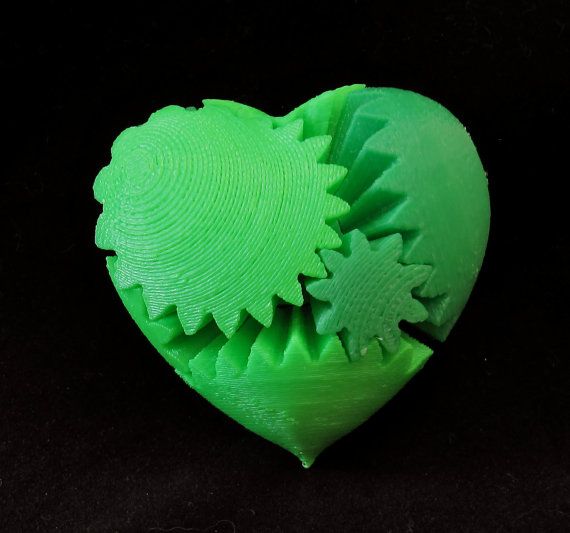Manufacturing with concrete 3d printer
3D Concrete Printing
Sikacrete® 3D materials for fast and precisely printed concrete
Contact Us
Concrete 3D Concrete Printing Article Architect Contractor
3D concrete printing (3DCP) is a form of cementitious, additive manufacturing used to fabricate buildings, houses or construction components in completely new shapes not previously possible with traditional concrete formwork. Sika offers Sikacrete® 3D material solutions for printing concrete rapidly, precisely, and inexpensively according to your project needs.
Contact us
Image above: Affentranger 3DCP
Expertise in 3D Concrete Printing
For this content to be displayed, you need to accept all cookies in the cookie settings and confirm your selection or by clicking the “Allow All” button.
Digitalization in Construction
Traditional reinforced concrete has been used for decades as an economical construction method. A shift is happening with the implementation of digital technology. As interest in digital tools and processes grows, so too the interest is increasing to use 3D concrete printing (3DCP). Digitalization is the driver aiming to improve productivity and save time, while offering something truly unique.
Many entrepreneurs and institutes see the potential to use additive manufacturing or 3D printing in construction. There is increasing demand from owners, architects, engineers, and contractors who can imagine the design flexibility and potential.
Sika aims to link this passion for 3DCP by offering innovative 3D concrete printing materials and solutions.
Image: Affentranger 3DCP
Image: Besix
"Digitalization is changing every aspect of construction and the entire life cycle of a building, from the design process and automated construction all the way to maintenance." Frank Höfflin (Head Operations, Quality and EHS at Sika)
Go Back Up ⯅
How Does 3D Concrete Printing Work?
Image: Pikus
- A print head/nozzle is mounted onto a robot arm or gantry.
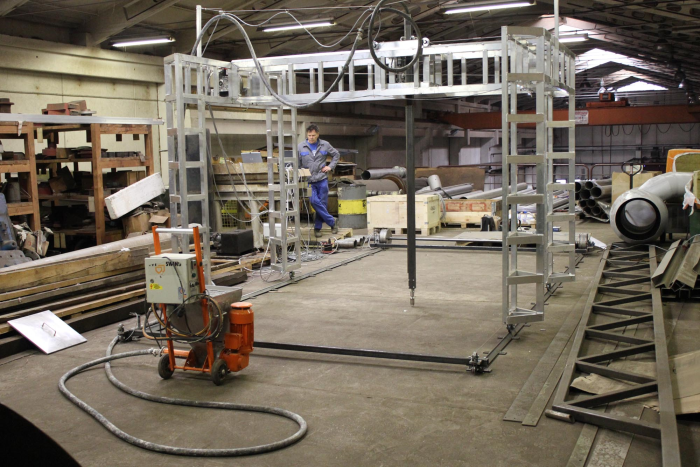
- The print head/nozzle is connected to a pump with a hose pipe.
- The components of the material are mixed.
- The mix is pumped into the print head/nozzle.
- Lines are extruded on top of each other.
- Additions or admixtures can be added to alter the properties of the mix.
What Equipment is Needed?
Image: Pikus
- Positive action pan mixer for cementitious materials
- Pump for conveying fresh mixed material continuously
- Sufficient length of pipe to connect the pump and print head
- Robot arm or gantry, including control software
- Print head/nozzle
- Suitable software for translating a 3D computer model into a machine program, often referred to as slicing
Go Back Up ⯅
What Type of Objects Can Be 3D Printed?
The possibilities are endless when it comes to 3D concrete printing. It allows you to create custom objects not feasible with traditional concrete casting methods. They can be smaller components like architectural furniture, or large-scale, fully-printed buildings and civil infrastructure. Sika has experience with all types.
They can be smaller components like architectural furniture, or large-scale, fully-printed buildings and civil infrastructure. Sika has experience with all types.
Image: Constructions 3D
On-site printing
Image: Affentranger 3DCP
Infrastructure & civil engineering
Image: Affentranger 3DCP
Formwork
Image: Besix
Facade elements
Image: Besix
Modular building
Image: Affentranger 3DCP
Building components
Image: Affentranger 3DCP
Architectural walls
Image: Affentranger 3DCP
Stairs
Image: Pikus
Outdoor Furniture
Image: Pikus
Indoor Furniture
Image: Affentranger 3DCP
Colored concrete
Image: Pikus
Customized projects
Go Back Up ⯅
Sika Products
Sika offers comprehensive Sikacrete® 3D solutions for printing concrete rapidly, precisely, and inexpensively according to your project needs. With a global footprint in over 100 countries and more than 100 years of history in cement and admixture technology, Sika can support you around the world to start or improve your 3D concrete printing business. In addition to 3DCP products and technical support, we have a wide range of solutions to add value to your entire project.
With a global footprint in over 100 countries and more than 100 years of history in cement and admixture technology, Sika can support you around the world to start or improve your 3D concrete printing business. In addition to 3DCP products and technical support, we have a wide range of solutions to add value to your entire project.
Sika is actively seeking partners to develop materials which work with different types of 3D concrete printing equipment. Contact us today.
1K
One-component
2K
Two-component
Admixtures
and compatible solutions
Are You Getting Started in 3D Concrete Printing?
Image: Affentranger 3DCP
Two-Component 3D Concrete Printing is for You
2K or 2-component is used to refer to the number of modules in a material to make a product. Sika’s award-winning 2K system is a gantry equipment and accelerated printing materials together in a unique turn-key solution fully
developed by Sika. This is an automated system utilizing several existing Sika technologies to produce very fast, precise, and high-quality printing.
This is an automated system utilizing several existing Sika technologies to produce very fast, precise, and high-quality printing.
The gantry system was developed by Sika and is fabricated under license with one of our partners. It consists of:
- Patented mixing station
- Pump
- Gantry
- Patented printing head
- Computer and software
Also available from Sika are the only compatible Sikacrete®-7100 3D printing materials specially developed with the Sika 3DCP gantry equipment.
Your Benefits
| Industry-Ready |
|
| Technical Support |
|
| High Quality |
|
| Increased Productivity |
|
| Add-Ons |
|
Image: Affentranger 3DCP
Sika Solution and Advantages
Sikacrete®-7100 3D consists of a cementitious powder with fibers and liquid polymer which is combined with water in the mixing station. Additional colors can be added to enhance the appearance. An activator is added in the print head which provides setting on demand.
Additional colors can be added to enhance the appearance. An activator is added in the print head which provides setting on demand.
- High compressive strength
- Fast printing speeds
- Adjustable setting time
- Long open time
- Printing at angles
Contact us
Go Back Up ⯅
Are You Already into 3D Concrete Printing?
Image: Constructions 3D
One-Component 3D Solutions Available
Sika provides cementitious materials for printing objects with your equipment. There are numerous types of mixers, pumps, and robotics on the market. To achieve a successful print, the equipment and material must work together. All these factors play a significant role in achieving optimal results of the finished concrete. Sika works with our partners to evaluate the print quality and find ways to improve it.
Types of information we can discuss:
- What type of equipment do you use?
- What type of objects do you print?
- What line widths, heights, printing speed and ambient temperatures are you working with?
- What are your open time, setting time, strength and performance requirements?
- Do you have any special requirements e.
 g., testing, colors, maximum grain size, packaging?
g., testing, colors, maximum grain size, packaging?
Your Benefits
| Technical Support |
|
| High Quality |
|
| Increased Productivity |
|
| Add-Ons |
|
Sika Solution and Advantages
Sikacrete®-751 3D and Sikacrete®-752 3D are one-component products which need to be mixed with water.
- Accelerated products
- Highly thixotropic
- Ready-to-use by adding water
- Low shrinkage
- Small grain sizes for less equipment wear
1K 3DCP Process
Design
Dosing
Mixing
Pumping
Extrusion
Curing
Go Back Up ⯅
Do You Need Additional Products?
A Full Range of Compatible Solutions
Sika has a range of compatible products to enhance and improve your entire 3D concrete printing project including concrete admixtures, filling, grouting, leveling, protection, sealing, bonding, strengthening and fixing.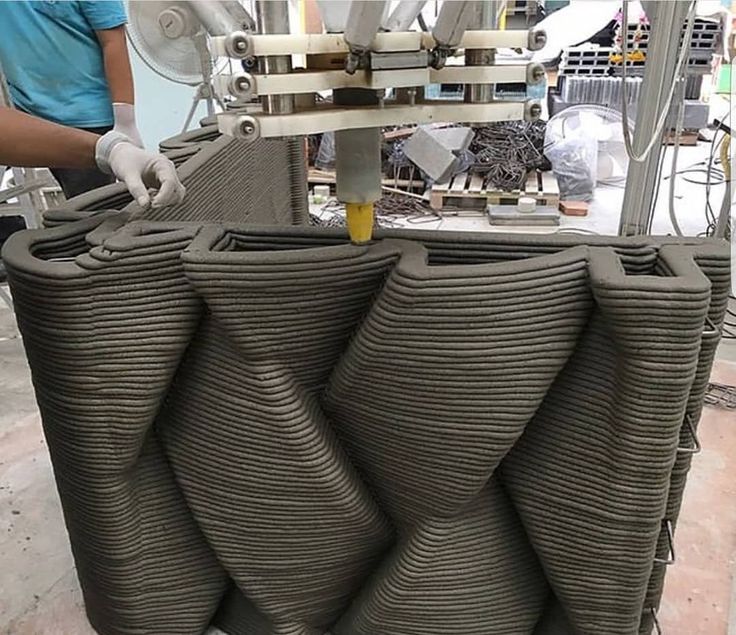
Contact us
Go Back Up ⯅
What's Been Printed with Sika
Collection of Sika 3D concrete printed elements columns towers shapes forms
Collection of Sika 3D concrete printed elements columns towers shapes forms
Collection of Sika 3D concrete printed elements columns towers shapes forms
Collection of Sika 3D concrete printed elements columns towers shapes forms
Sika Besix 3D concrete printed office building facade panels
Sika Besix 3D concrete printed office building facade panels
Sika Besix 3D concrete printed office building facade panels
Sika Besix 3D concrete printed office building facade panels
Close up texture of Sika 3D concrete printed element
Close up texture of Sika 3D concrete printed element
Close up texture of Sika 3D concrete printed element
Close up texture of Sika 3D concrete printed element
3D Concrete Printing
3D Concrete Printing
Close up texture of Sika 3D concrete printed element
Close up texture of Sika 3D concrete printed element
Close up texture of Sika 3D concrete printed element
Close up texture of Sika 3D concrete printed element
Close up texture of Sika 3D concrete printed element
2K 3D concrete printing with Affentranger 3DCP
Close up texture of Sika 3D concrete printed element
2K 3D concrete printing with Affentranger 3DCP
Close up texture of Sika 3D concrete printed element
2K 3D concrete printing with Affentranger 3DCP
Close up texture of Sika 3D concrete printed element
2K 3D concrete printing with Affentranger 3DCP
Download a Case Study
Go Back Up ⯅
Sika's Partners
If you would like to benefit from partnering with a global player in 3D concrete printing technology, get in touch with Sika today.
Frequently Asked Questions
How can I test Sika products with our own 3D printing equipment?
Please fill out the contact form, and we will reply to your request.
Is there an email newsletter I can sign up for to receive updates on Sika's 3D concrete printing?
Currently, we do not have a newsletter, although we are active on social media.
Does Sika sell 3D concrete printers?
Sika does not sell 3DCP equipment. We have developed a gantry printer and license the construction to an equipment manufacturer. For more information, please contact us.
How can I do feasability studies to compare 3D concrete printing to traditional construction methods for my project?
Costs associated with 3D concrete printing are best discussed with equipment suppliers. The cost of traditional construction methods very much depends on the costs of materials and labor in your geographical area. A local contractor can possibly assist you to make the comparison.
A local contractor can possibly assist you to make the comparison.
Is it possible to use local materials and concrete with 3D concrete printing?
Sika has worldwide production factories. Where possible, we would like to produce locally to reduce transportation costs and time. If you would like to use local concrete to 3D print, Sika can also assist with pre-testing the concrete using Sika admixtures.
Does Sika sell concrete or cement admixtures suitable for high resolution 3D concrete printing?
Yes, Sika has a range of concrete admixtures and mortar additives that can help to improve the printing consistency according to the project requirements.
Does Sika support with concrete mix design for custom 3D concrete printing needs?
Yes, Sika can help support with concrete mix design. This is our daily business to support ready-mix and precast concrete manufacturers.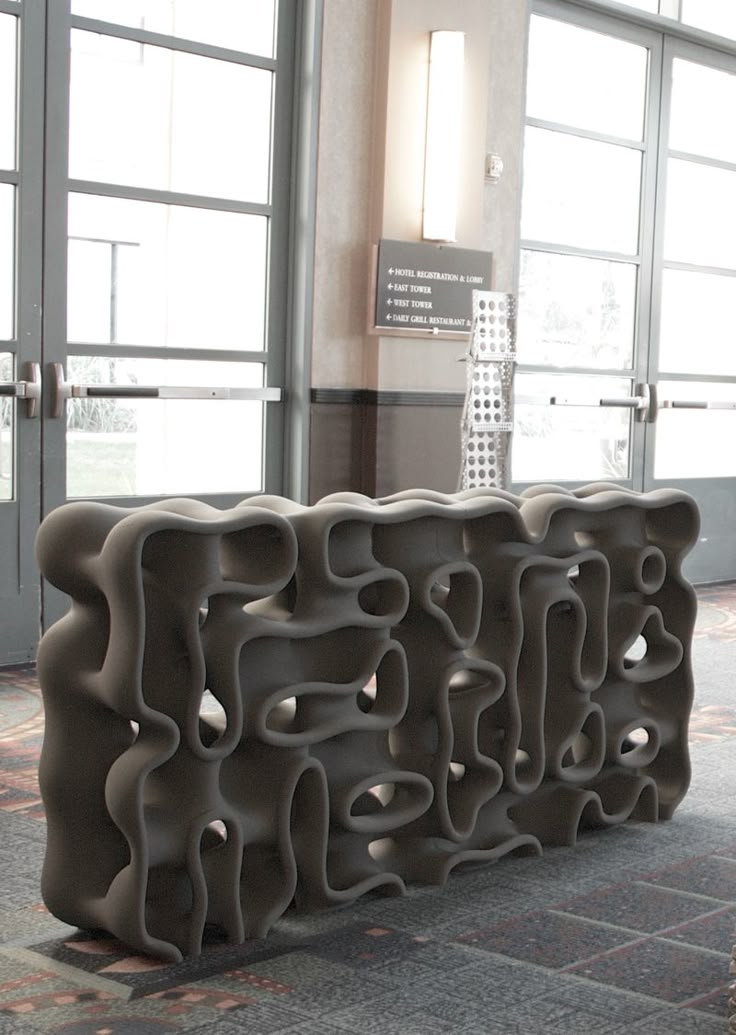
Would Sika partner with researchers and universities in 3D printing technology?
Sika partners with many institutions carrying out research. Please contact us to see how we can partner together.
Go Back Up ⯅
Contact Us
Contact Sika to Inquire About This New Technology
Whether you are an architect who wants to revolutionize your design with 3D concrete or a contractor who wants to get started in 3D concrete construction, Sika’s technical experts can advise you.
Please fill out the contact form below.
Name Error Message
Company Error Message
Zip Error Message
City Error Message
Country Error Message
E-Mail Error Message
Tell us more about your 3D printing needs. Error Message
Download a Brochure
Go Back Up ⯅
You May Also Be Interested In
How does a concrete 3D printer work?
Published on January 8, 2021 by Amelia H.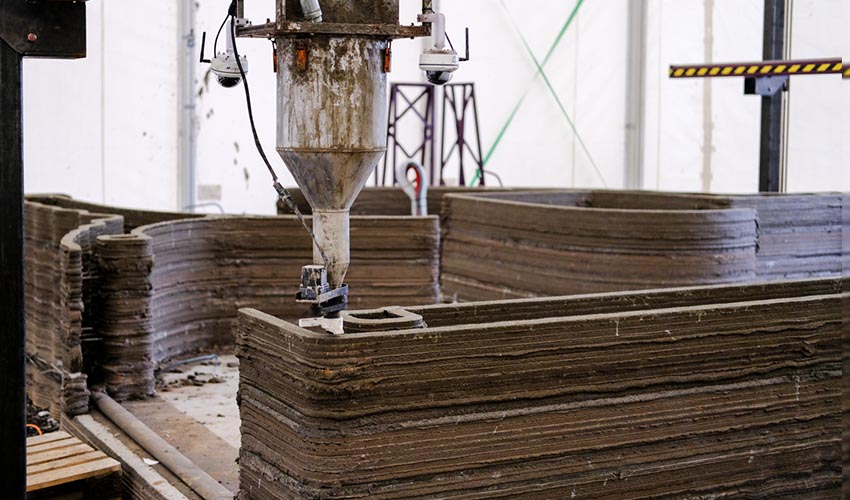
In recent years the role of additive manufacturing in the construction industry has become increasingly important. In particular, concrete 3D printers have been continuously gaining popularity among architects and construction firms. After water, concrete is the most widely used substance in the world. Concrete is a composite material that consists of water, cementitious compound, and aggregate (fine and coarse particles of sand, gravel, crushed stone, and similar substances), all of which exist in abundance. As such concrete is an inexpensive, and thus very popular, material. However, concrete 3D printers themselves are expensive. Machines designed for construction tend to be priced anywhere from around $180k to over $1M. Nonetheless, there are several benefits of using a concrete 3D printer rather than traditional manufacturing methods. It is faster, cheaper, safer, and more efficient. A concrete 3D printer not only produces minimal waste, but also significantly reduces the number of active participants needed on site as well as the length of supply chains. Moreover, using a concrete 3D printer, construction can be completed to a significantly higher degree of resilience and geometric complexity.
Moreover, using a concrete 3D printer, construction can be completed to a significantly higher degree of resilience and geometric complexity.
A standard concrete 3D printer functions very similarly to a standard FDM printer. This is primarily because both technologies are based on material extrusion. As such their processes strongly resemble each other: first a digital 3D model is created using a 3D modelling software; the model is then sliced and translated into G-Code; the G-Code then guides the printhead which deposits material pumped from a cement mixer in layers until the final piece is produced. A typical concrete 3D printer is designed to additively manufacture parts though material extrusion, consisting of a robotic arm, with one end attached to the printhead, and the other either to a gantry or crane-like robotic arm system. Depending on the type of concrete 3D printer its design, ability, and process varies. Each has distinct benefits and drawbacks depending on the desired application. The build volume, print-resolution, practicality, and efficiency of a concrete 3D printer will vary depending on its system, technology, manufacturer, and intended applications.
The build volume, print-resolution, practicality, and efficiency of a concrete 3D printer will vary depending on its system, technology, manufacturer, and intended applications.
Concrete 3D printing saves cost and time (Photo Credit: Mike Jazdyk)
Gantry Concrete 3D Printer
The term gantry comes from the gantry-style overhead structure which supports the printer. While this kind of concrete 3D printer is a popular choice for commercial construction projects, they are rarely used for smaller projects, largely due to the sheer size and associated limited portability, as well as the technical effort required to set up and dismantle them. This type of concrete 3D printer typically operates on a cartesian coordination system consisting of x, y and z axes. These axes are defined by the rails and beams of the supporting structure. The x-axis corresponds to the length of the rails that move the printer forwards and backwards, while the y-axis corresponds to the length of the rail carrying the printhead and connecting the pillars, which in turn are defined by the z-axis and move up and down.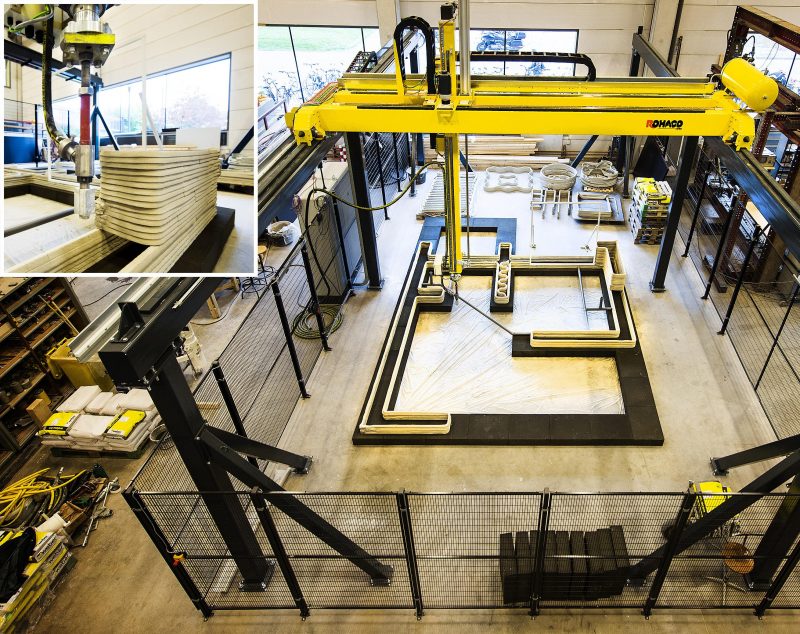
For example, ICON’s 3D printer, the Vulcan II, functions on this basis. With a build volume of 260 x 850 x 260 cm, weighing around 1.7 tonnes, the printer is roughly 2.5 metres tall and 8.5 metres wide. The machine exclusively uses ICON’s proprietary concrete material, Lavacrete. Like most large-scale concrete 3D printers, the Vulcan II itself is expensive, priced at just under $250’000. Despite this, additive manufacturing significantly reduces construction costs, as such many construction companies will opt to hire the machine instead. In 2019, ICON’s printer successfully built a house for under $4000, in just 24 hours.
ICON’s Vulcan II incorporates a gantry system with x, y, and z, axis. (Credit: ICON)
Robotic Arm Concrete 3D Printer
A mechanised or robotic arm concrete 3D printer is supported by a crane-like structure and typically operates on 6 axes. This means that it is possible to create more complex geometries and higher resolution parts than is possible with a gantry-based machine.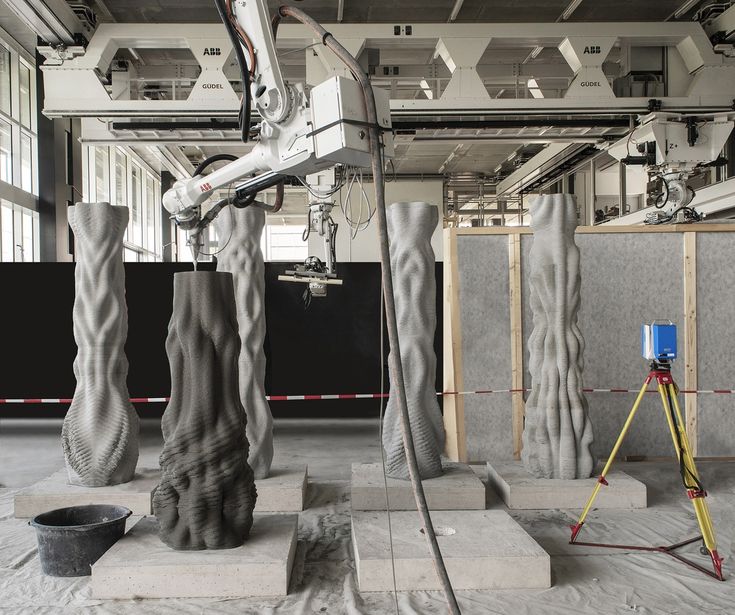 This type of 3D printer also has the added benefit of increased portability and compactness and is thus easier to both set up and take down. Historically these have had limited build volumes and were thus restricted to constructing smaller parts, recent advances have enabled the development machines with larger build volumes, rivalling that of gantry printers. Robotic arm printers tend to be more expensive than those with gantry systems.
This type of 3D printer also has the added benefit of increased portability and compactness and is thus easier to both set up and take down. Historically these have had limited build volumes and were thus restricted to constructing smaller parts, recent advances have enabled the development machines with larger build volumes, rivalling that of gantry printers. Robotic arm printers tend to be more expensive than those with gantry systems.
Russian startup, Apis Cor made headlines in 2018 after managing to build a 400-square-foot-home being built from scratch using their proprietary robotic arm concrete 3D printer. The project was completed in just 24 hours in Moscow and cost just $10,000. Two years later the company made headlines again after successfully constructing the world’s largest 3D printed building in Dubai with their proprietary additive manufacturing technology.
Apis Cor’s robotic arm concrete 3D printer has 6 axes. (Photo Credit: Apis Cor)
A final word
Despite the common misconception that a building can be constructed in its entirety by a concrete 3D printer alone, typically only the walls and foundations are additively manufactured. Nonetheless, concrete 3D printing has had an enormous impact on the construction industry. Over the last decade in particular, several construction companies specialising in additively manufacturing concrete have emerged. The Danish company, COBOD constructed Germany’s first ever 3D printed residential building using their BOD2 gantry-style concrete 3D printer, and have since announced a three-story residential building project, that has already begun construction and will have a surface area of 380 square meters. Concrete 3D printers have been used to construct housing in several countries across the world including Germany, Belgium, Dubai, Morocco, and France, as well as an office in Denmark.
Nonetheless, concrete 3D printing has had an enormous impact on the construction industry. Over the last decade in particular, several construction companies specialising in additively manufacturing concrete have emerged. The Danish company, COBOD constructed Germany’s first ever 3D printed residential building using their BOD2 gantry-style concrete 3D printer, and have since announced a three-story residential building project, that has already begun construction and will have a surface area of 380 square meters. Concrete 3D printers have been used to construct housing in several countries across the world including Germany, Belgium, Dubai, Morocco, and France, as well as an office in Denmark.
House constructed with COBODs concrete 3D printer. (Photo Credit: COBOD)
The rapid development concrete 3D printing technology has led to several impressive innovations. For instance, Twente Additive Manufacturing (TAM) has combined gantry and robotic arm systems to build a 9-axis printer, comprising the standard 6 axes of a robotic arm concrete 3D printer, as well as the additional elevation, translation and rotational cartesian axes of the gantry system. Several of these advances have globally significant applications to issues such as homelessness and the preservation of natural resources.
Several of these advances have globally significant applications to issues such as homelessness and the preservation of natural resources.
What do you think about concrete 3D printers? Let us know in a comment below or on our Facebook and Twitter pages! Sign up for our free weekly Newsletter here, the latest 3D printing news straight to your inbox!
Concrete 3D printing: still ahead
Back to Concrete Issues main pageAdditive manufacturing, more commonly known as 3D printing, has been around since the 1980s. 3D printers have long been available for home use, so it's not surprising that industrial companies have begun to explore the possibility of using them in construction.
The use of 3D technology is widely and frequently discussed in the construction industry. Almost every week there is news of plans to 3D print structures ranging from bridges to houses that developers say can be built in one day. However, the initial enthusiasm in the media is quickly fading as there is less and less news of successful projects in this area. To shed some light on this topic, we asked a few experts for their opinions on the current state of 3D printing in construction.
To shed some light on this topic, we asked a few experts for their opinions on the current state of 3D printing in construction.
One of the approaches to automation
There is a lot of hype in the construction industry around 3D printing technology, which, however, is still at an early stage of development. Concrete is a difficult material for 3D. A construction 3D printer works by applying concrete, layer by layer, through a nozzle, and in order to flow out of it, the concrete must be liquid. After printing, on the contrary, the material must quickly lose most of its fluidity in order to retain the printed form. However, at the same time, it should not harden too quickly to give the layers time to stick to each other. If layers are simply applied on top of others, without any connection between them, this will result in a weak structure, with no tensile strength. All this means that we cannot use ordinary concrete in 3D printing, and each structure needs a special type - always with different impurities.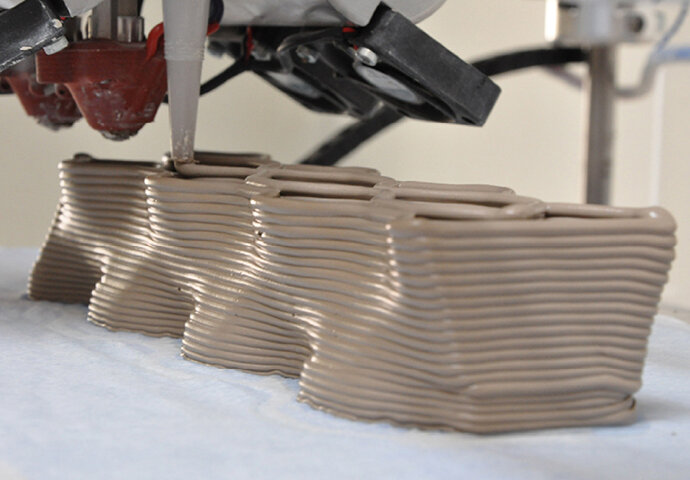
We must also take into account the complexity of the frame of the building that is being built. 3D printing is best for simple designs. Wall structures in Northern Europe, for example, are quite complex, and using 3D printing in them is quite problematic. The structure of the sandwich panel itself is a challenge for 3D printing: it has three layers - internal concrete, insulation, and external concrete. In addition, there are usually various wiring components inside the wall structure. Printing a three-layer structure and assembling electrical components during the printing process is not an easy task. The entire wall structure needs to be redesigned for 3D printing.
The current speed of 3D printers is incomparable with modern precast concrete factories. In addition, the quality of products from factories is much better than that obtained using additive technologies. 3D printing makes it possible to produce complex shapes, but in the case of typical concrete structures such as wall panels, its efficiency is far from that achieved by modern precast concrete technology.
Despite the limitations, we must be open to the possibilities that 3D printing brings. It can be considered as one of the approaches to increase the level of construction automation. If you look objectively, the future of 3D printing in construction is not clear. It may be one of the tools to help develop automation in construction, but certainly not the only one.
We must keep in mind that one of the main advantages of concrete is that it can be cast into shapes, create images and structures of varying complexity. Various types of concrete surface treatment are also currently available. Concrete construction is based, as a rule, precisely on its flexibility. With the help of 3D printing, we will completely change this. 3D printing certainly gives us new opportunities, but at the same time we lose some of the benefits of using concrete.
Jouni Punkki
Professor of Practice (Concrete Technology)
Aalto University, Helsinki, Finland
Jouni Punkki
Professor of Practice (Concrete Technology)
Helsinki Aalto University3
Financial viability is a big issue in the use of 3D printing in construction
We should consider 3D printing in construction as a very interesting technology that has some potential in the future. From a safety point of view, there are rules governing construction of any kind, and of course there are requirements for adding reinforced bars as supports in 3D framing. Since this technology is new and regulatory practices are constantly changing, these rules can be difficult to comply with. But I don't think there is any reason to be concerned about the safety of 3D printed structures.
From a safety point of view, there are rules governing construction of any kind, and of course there are requirements for adding reinforced bars as supports in 3D framing. Since this technology is new and regulatory practices are constantly changing, these rules can be difficult to comply with. But I don't think there is any reason to be concerned about the safety of 3D printed structures.
Concrete 3D printing faces the same challenges as other industries embracing this technology. Using molds to make components by casting will be much faster because with 3D printing you need extra time to make sure the previous layer can support the structure before adding the next one.
One advantage that 3D printed structures can provide over conventional building methods is that they are much easier to incorporate smart technologies such as sensors, making them easier to integrate into the smart city concept. From this point of view, it is much more difficult to modernize existing houses built using traditional building technologies.
Developing new technologies takes time. It's about testing, learning, and trying to figure out all the different variables. 3D printing of concrete structures is likely to become more commonplace. However, what role it will take in the construction industry, we cannot yet predict.
The big question, of course, is can we make it financially viable? Is this technology something that customers will pay for? Will the cost of acquiring special 3D technologies be competitive, or at least comparable to what is on the market? There are other ways to achieve similar results, and these options are cheaper and more readily available to the construction industry.
Jouni Partanen
Head of Department (Advanced Manufacturing)
Faculty of Mechanical Engineering
Aalto University, Helsinki, Finland
CONCRETE EXPERIMENT 01 Design: Ashish Mohite, Michal Trpak Concrete Printing done by: Hyperion robotics Photographer: Umění ve městě 2019CONCRETE EXPERIMENTS Design: Ashish Mohite, Kunal Chadha Concrete Printing done by: Hyperion robotics Photographer: Ashish MohiteLots of claims, but not much evidence yet
There are several companies in the US and Europe that claim to be 3D printing concrete, but in the last two to three years they have only completed small projects such as private homes. One Russian company was erecting a three-story building in Dubai, and another company, already in Estonia, is now building a house using 3D printing. We help them make it a reality, but the project is still far from being completed.
One Russian company was erecting a three-story building in Dubai, and another company, already in Estonia, is now building a house using 3D printing. We help them make it a reality, but the project is still far from being completed.
Construction is a highly regulated industry, and one of the reasons why 3D printed concrete is no longer commercially available is the time it takes to get permits. In addition, the concrete used for 3D printing is more expensive than traditional concrete materials due to the admixtures needed to ensure the correct composition.
However, this technology continues to evolve. When a wall is 3D printed, it looks like a sandwich with two sublayers to make room for pipes and ventilation. In Zurich, it was possible to build a three-story house using various technologies. They invented a "smart stove" that had all the heating elements inside, however very expensive 3D printed molds were used for this. It was a pilot project to prove that the concept could be implemented.
Most companies involved in 3D printing in construction, of course, say that this technology is better than precast concrete, but in reality this has not yet been proven.
Ashish mohit
Doctoral
Mechanical Engineering Faculty
Aalto University, Helsinki, Finland
Ashish Mohita
Department of Engineering
AALTO University, Helsinki, Finlander, Finland
3D printing: promising, but it has a long way to go
The current technology used in construction is pouring concrete. To make it financially viable, you must keep the structure simple and standardized. If you don't, the price will go up as you have to make and customize different molds. In addition, simple products are not only visually unattractive, but also require a large amount of concrete in the manufacture. With 3D printing, we can reduce the amount of concrete used by about 50% by focusing, for example, on where the wall bears the load. We can print lines to make a slab and only use materials where we really need them. However, this means that we must also develop new design methods to benefit from the technology. Unfortunately, this takes time.
We can print lines to make a slab and only use materials where we really need them. However, this means that we must also develop new design methods to benefit from the technology. Unfortunately, this takes time.
The industry is focused on using currently available material. I think if you're going to change something, you'd better look at it from a social perspective and from a sustainability perspective. I saw an opportunity when working with digital concrete: everyone supports changing the composition of concrete because 3D printing is not perceived as a threat to the traditional construction industry.
I think 3D printing opens up a lot of possibilities for making smart materials. Why not tie the conductive materials directly into the concrete so that you no longer have to insert wires into concrete structures after they are made? With 3D printing, you can add inches, make material changes, make electrical connections in the right place, make concrete transparent where you want. It's about combining 3D printed concrete with smart technology to ultimately benefit us as a society.
It's about combining 3D printed concrete with smart technology to ultimately benefit us as a society.
One of the barriers is economic viability. A technology such as 3D printing will not be widely adopted unless there is a visible economic benefit at some point. Thus, manufacturers could consider expanding their business model so that construction is valued not only by the price of the house or structure being built, but also by the impact it has on our ecosystem and its sustainability.
However, there is a big difference between 3D printing a bridge and a house. We announced a 3D printed house project in Eindhoven two and a half years ago, and the first house has yet to be built. The complexity becomes apparent already when compared with the first printing bridge, which was opened within half a year after the start of the project.
We found this to be terribly difficult because building a house involves complex systems - HVAC, electricity, internet connection - that you have to consider. It took us a long time to figure out how to do this, and I think it will be many more years before we can print houses or buildings on a larger scale. Bridges are much easier to build using 3D printing, as they have fewer details.
It took us a long time to figure out how to do this, and I think it will be many more years before we can print houses or buildings on a larger scale. Bridges are much easier to build using 3D printing, as they have fewer details.
Theo Sale
Dean of the Faculty of Built Environments
Professor of Structural / Concrete Design
Technical University of Eindhoven, The Netherlands
Theo Sale
Dean of the Faculty of Built Environments
Professor of Structural / Concrete Design
Technical University of Eindhoven, The Netherlands
Ideal for decorative elements, but not yet for structures
3D printing is a very interesting manufacturing system that we are following closely. It is already used in many industries such as steel and plastics, as well as in aeronautics, and especially in the production of aircraft parts. However, it is not widely used in the construction industry.
According to experts, there are still many barriers that need to be removed before 3D printing will leave its mark on construction, but I believe that it is the future of our business - it's just a matter of time.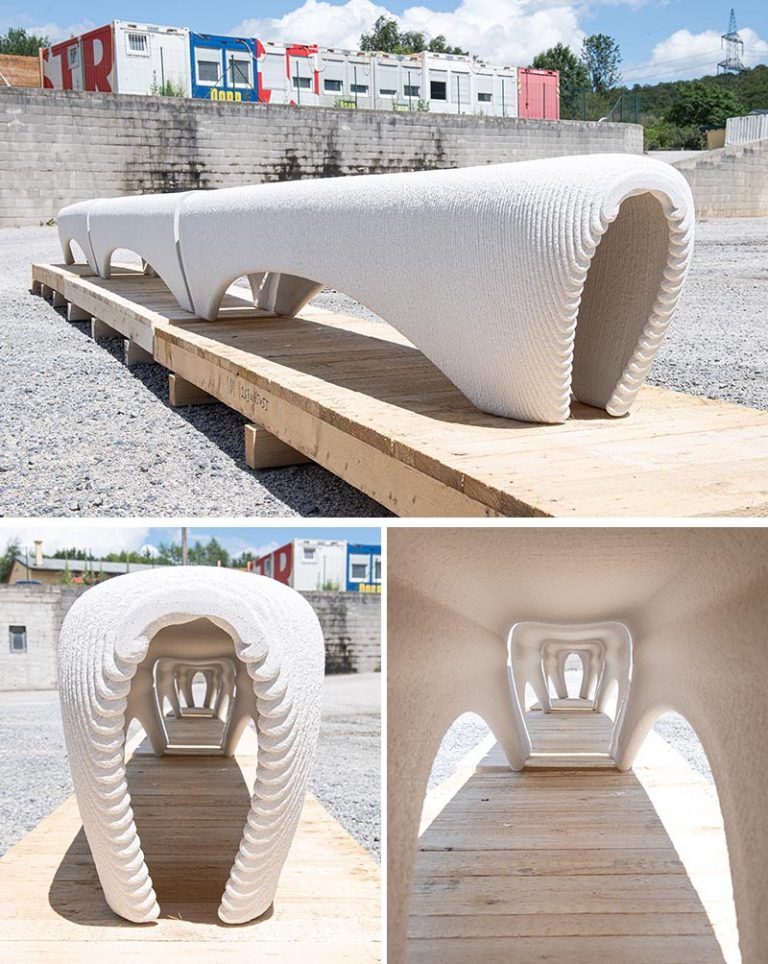 Now 3D printing is mainly used to create decorative items. Some cruise ships, for example, use 3D printed plastic and cellulose fibers as part of their interior design.
Now 3D printing is mainly used to create decorative items. Some cruise ships, for example, use 3D printed plastic and cellulose fibers as part of their interior design.
Although concrete is not yet widely used in 3D printing, it offers many advantages: fire resistance, strength and the ability to support heavy structural elements. This is what makes it an ideal material for 3D printing items such as statues or columns, especially since each of us needs something beyond the usual box-like prefabricated structures.
Decorative elements, of course, can also be molded from concrete, but this requires workers - craftsmen to equip the molds. One of the practical applications of 3D printing in construction is mold making. In complex precast concrete projects, mold tooling is always a challenge as it requires a lot of manpower and precision. If the molds were 3D printed, the process would be easier and less labor intensive.
Tested to 3D print entire frames using concrete for projects such as small single-family cottages.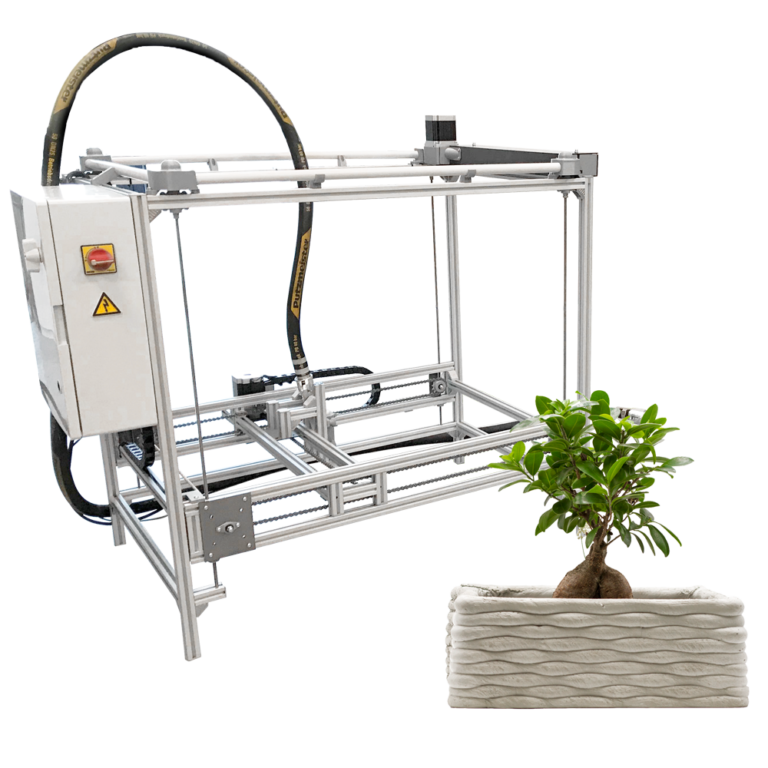 It is good that these tests are being carried out, but at the same time it is already clear that 3D printed concrete still has a long way to go. There are technical and quality issues that need to be addressed, especially when we start thinking about 3D printing large structures such as multi-story buildings. Building with 3D printed concrete also faces an economic challenge. The additives required for concrete to be used with 3D printing technology are very expensive.
It is good that these tests are being carried out, but at the same time it is already clear that 3D printed concrete still has a long way to go. There are technical and quality issues that need to be addressed, especially when we start thinking about 3D printing large structures such as multi-story buildings. Building with 3D printed concrete also faces an economic challenge. The additives required for concrete to be used with 3D printing technology are very expensive.
Building entirely based on 3D printed concrete – where all the reinforcement, HVAC and sewerage systems are integrated rather than installed separately as is done today – is simply not possible at present. Perhaps in the future, when concrete technology is developed to the right level, 3D printed structures will become a viable option.
Petteri Laitinen
Vice President, Projects and Services
Elematic
Petteri Laitinen
Vice President, Projects and Services
Elematic
3D printing with concrete [expert opinion] - Studia3D
02/16/2020 in Expert's Blog, Observations, Equipment, Technologies . And I made certain conclusions for myself, which I will try to briefly outline.
And I made certain conclusions for myself, which I will try to briefly outline.
Actually, when it comes to 3D printing with concrete, my opinion is mixed. I'll try to explain why:
Concrete 3D printing technology.
Concrete 3D printing is a semi-finished product. Not because 3D printing with concrete needs additional post-processing (Any production technology in most cases does not give the final result, be it a milling machine, casting, etc. It always requires bringing the product to customer requirements), but because the process of 3D printing with concrete has so many crutches and sores that it becomes very difficult to call this process 3D printing.
Administrative building. Construction. Dubai. It was built by a Russian guy. Read more here.
Of all the solutions on the market that I could find, the concrete printing process is a layer-by-layer application of concrete, which is essentially a repetition of the well-known FDM technology.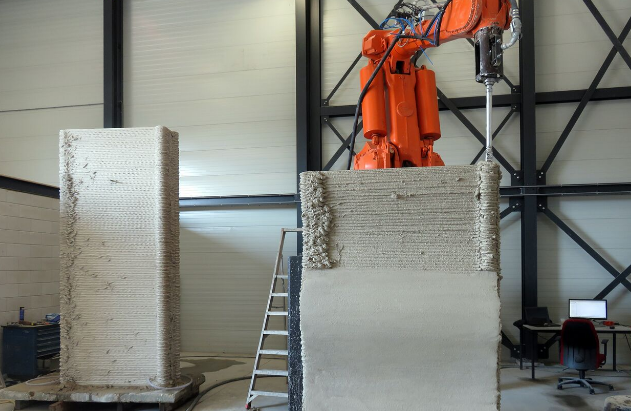
Concrete 3D printing technology. How does this happen.
But it wasn't there. Contrary to traditional filament printing, concrete does not use supporting structures during model growth. Instead, workers have to fence supports made of wood, plastic, foam and just improvised means. Although this approach is characterized rather not by technology, but by materials.
Administrative building. Construction. Dubai.
Concrete support structures are not easy to break if present. However, this is not an excuse. Should I buy an industrial building 3D printer and still have the workers to run around and build something? Only now not formwork for pouring concrete, but supporting structures for a 3D printer. So it is necessary to teach the workers what support structures are. But even if I print in segments, then to assemble the whole structure, I will already need several cranes and more qualified staff of "so-pro-matchers" so that it all does not collapse to hell.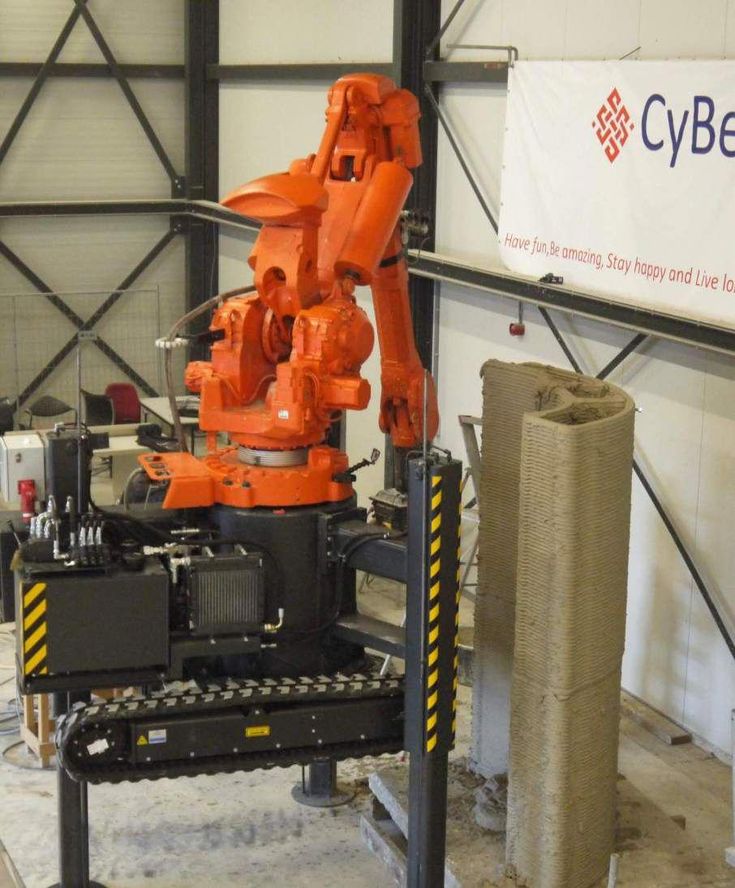
3D printed bridge. China.
Money.
However, despite all the difficulties and shortcomings of the technology, the main advantage of using such technologies in 2020 is the presence of your own, already established, construction company. The use of 3D printing technologies will essentially be the hallmark of the company.
3D printed Dubai Future Foundation headquarters. Dubai.
And if not a solution to production issues, but an excellent publicity stunt. In fact, there is not even an input investment. Investments in advertising, if you can justify this expense.
Conclusion:
If you want to open a business with 3D printing in 2020, it is only in the concrete segment. The remaining segments are already simply occupied and have already been studied quite deeply. Building houses on a 3D printer is a tempting and profitable business. But! This area seemed to me irrelevant for this year in terms of starting a business and for such established centers of additive technologies as Studia3D in terms of expansion.









